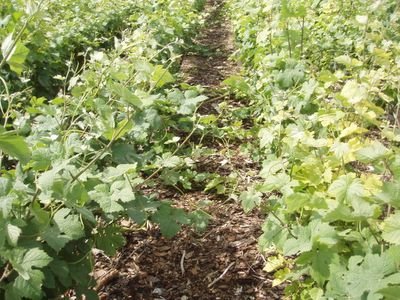

Our young man is still busy with the pallisage. The objective is to leave the rows as tidy as in the picture. He has still at least another week of work left.
The starting point has grown into lots and lots of messy, green stems, that hook themselves to all the wrong places, or has a direction towards the neighbouring row rather than staying in line with its own. All these stems must be put nicely back behind the double thread, so they will stay with the vine, where they grow. A work of patience, because if you do it too fast or impatiently, there is a big risk, that the soft stems will break. And from the start you do the palissage excactly to avoid this.


He does everything left to do connected with the binding up the vine. The palissage itself, but on top of that he lifts the double thread to the top level - a bit late, the stems are long now, and summer has already come up with several thunder storms - and places the little clip, that keeps it all together.
Alain has begun to buy biodegradable clips. They are made of... and it should reduce the mess between the rows. It is not that we throw lots and lots of the old agrafes, that are sometimes homemade - bend iron - and sometimes made of plastic. But if they slip between our fingers when we are out to remove them, we do not stop to look for them between the wooden chips on the ground. It takes far too much time.
The future palissage
A story in the June-edition of Le Vigneron Champenois explains - quite technically and detailed - how you with a new type of metal clips or arms can manage the palissage faster. The principle is, that you place the arm in a hook at each iron post, where it can have an open - a very open V - and a closed - a very closed V - position. Before the palissage the arm is left in its open position, where it stretches the thread so the vine is allowed to grow. It also provides the necessary workspace for the pruning and attaching.
When the time of the palissage is up, you change the adjustment of the metal arm to the closed position, which will squeeze the stems towards the espalier. The trick is that the two liftings and the staple is thus rationalized into one single operation.
So far the systems - there are several - have been tested by the technical department of the CIVC (Comité Interprofessionnel du Vin de Champagne). Their conclusion is that only after several years of usage, you may start saving time - as much as 40-50 percent - but also that the product is still not technically mature. But at some stage it will probably be interesting to half the amount of work hours by such a seemingly simple technique. However, bearing the reservations of the technicians in mind, I suppose the technique so far is not as simple to work with as it seems.


The flowers are almost finished now. The pollination is over, but we will still have to wait some weeks to have an idea of the result. As far as we know the weather has been okay in the area, so probably, hopefully, it is fine.
På dansk
Copyright: The copyright for text and photos at bobler.blogspot.com belongs to Solveig Tange. You may use my articles, photos or parts of them for non-commercial use and if I am credited as the author. Feel free to link to this site but not in your own frameset please.
No comments:
Post a Comment